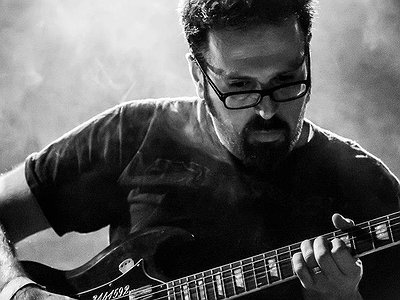Could you describe your creative process on the basis of a piece or album that's particularly dear to you, please? Where did the ideas come from, how were they transformed in your mind, what did you start with and how do you refine these beginnings into the finished work of art?
DG/GLP: We can recall our first album “Commuting” as a perfect example of our ideal compositional flow: we met thanks to common friends, we started jamming together for a couple of weeks after office time. Then we pressed the record button and we kept jamming without a defined plan.
The album was ready relatively quick and after a few weeks we found a label willing to release it. What came afterwards was quite a surprise given the positive feedback received from the press, labels, venues and fellow musicians.
There are many descriptions of the ideal state of mind for being creative. What is it like for you? What supports this ideal state of mind and what are distractions? Are there strategies to enter into this state more easily?
GLP: Sometimes inspiration comes all of a sudden, and I need to grab my guitar and pedals as soon as possible to try to fix it and shape it. In other occasions I sit and play until something worth being further explored and developed comes out. Sometimes the notes lead, sometimes the sounds. In all cases, it always requires a lot of patience and dedication.
DG: Being quite a brainy guy, the creative state is the end result of a line of thinking, the final expression of a mental exploration that fluctuates between the rational and sub-consciousness. Actually each note has a story behind it and each time it is played I try to rewrite it. At the end the only strategy is to own an image, seek an answer and a solution to a problem.
How is playing live and writing music in the studio connected? What do you achieve and draw from each experience personally? How do you see the relationship between improvisation and composition in this regard?
DG: The two are quite connected in the Tropic of Coldness project. Despite relying on a defined composition structure, the execution is quite open allowing each time to explore different sonic nuances, both during our studio time and on stage. The common factor in both the studio and live situation is the intention of each composition, while the aesthetics’ of it evolve based on the surrounding inputs.
What personally I try each time to achieve is a connection first with Giovanni and then with the environment, a connection that becomes part of the composition and its execution. It does not happen all the time, but when it kicks in you feel the flow dominate the room.
GLP: Exactly, there is a compositional structure, but our tunes never sound the same, the improvisational component always plays a role, so there are never two identical versions of the same tune. In many cases, the improvised parts can sound so convincing that they are then integrated in the composition, and this is the most stimulating side of it.
How do you see the relationship between the 'sound' aspects of music and the 'composition' aspects? How do you work with sound and timbre to meet certain production ideas and in which way can certain sounds already take on compositional qualities?
DG/GLP: Actually our first album, “Commuting”, like the following ones, are a clear example of how we always treated the sonic matter manipulation as a critical aspect of the compositional process. While “Commuting” is more driven by guitar manipulation, “Unrelated Casualties” and “Demography of Data” found the centre of gravity in field recordings, their processing as instrumental voice to the compositional tension.
This might became less evident or, in other words, it has become more sophisticated with the most recent works, driven by a deeper research of new sonic balances in our relationship and between the different elements.
Our sense of hearing shares intriguing connections to other senses. From your experience, what are some of the most inspiring overlaps between different senses - and what do they tell us about the way our senses work? What happens to sound at its outermost borders?
GLP: In my case, music and sounds interact mostly with my sense of sight. Whenever I listen to one of our compositions that includes a field recording, I can easily picture the moment and the place where I recorded it, like in a sort of videoclip. And this happens also for the field recordings made by David, even if I obviously was not there when he recorded them.
I also remember a number of reviews of our records mentioning a “cinematic” quality of our music, as if it could be potentially used as a soundtrack. Sometimes I try to visualise the landscapes and scenes of these imaginary movies.
DG: Sound is a locking key to memories, images, states of mind that belong to our past or hide in our inner self. Amazingly, I can remember all the albums I own, I recall perfectly the emotional state of the day, where I got each of them, the circumstances. For instance, the day I bought the first album by Filter (“Short bus”) I had a huge headache caused by sinusitis and each time I happen to listen to any of the songs of the album, the headache comes back.
Art can be a purpose in its own right, but it can also directly feed back into everyday life, take on a social and political role and lead to more engagement. Can you describe your approach to art and being an artist?
DG: Any form of creation is the end-result of a thinking and an elaboration process. It might sound, at first, simplistic to say that we are all artist. In reality, it is a synthesis behind the complexity of deployed layers of technique and the semantic association that makes the artistic creation a piece of art. And this is exactly how both of us get together our ideas, finding the proper balance in mastering a technique to serve a conceptual synthesis.
GLP: Our latest record “Human kindness” is exactly an example of how we tried to convey a message about how we see the current social and political situation. For the first time we decided to include a note explaining what inspired our record and to whom we dedicated it. As our music is instrumental, we used the songs titles as chapters, or topics for discussion.
It is remarkable, in a way, that we have arrived in the 21st century with the basic concept of music still intact. Do you have a vision of music, an idea of what music could be beyond its current form?
DG: I like always to keep in mind and share Patrick Ness’ words: “The Noise is a man unfiltered, and without a filter, a man is just chaos walking”. Music has been bonded with human existence since the dawn of existence, there is evidence of the Neanderthal man being an experimental musician, building his own instruments to express an unknown expressive need. Therefore, music will always evolve together with us, mirroring our evolution as society, individuals, leveraging on the concurrent media and tools.
I bet streaming services will be based on AI, auto generative music intended not as an out of control form, but a computational tool with infinite power to unleash extremely visionary feelings.
GLP: Well, I’m not so sure that the basic concept of music is still “intact”. Even if we limit our analysis to the Western world only, we witnessed so many – in some cases drastic – changes to the way music is performed, accessed and used in the last 100 years.
Just think about how listening to music has changed in the last 40 years: when I was a child I remember people who invested loads of money in powerful equipment to achieve the highest possible quality of their listening experience, not to mention the fact that albums were listened in full, at home. The streaming service model, which makes you jump from a song/artist to another driven by the applications’ algorithm is a totally different experience, in which music often becomes a sort of background while you do another thing.
Ironically, to a certain extent almost all music has nowadays become ambient music, if we use the definition coined by Brian Eno in 1978.



